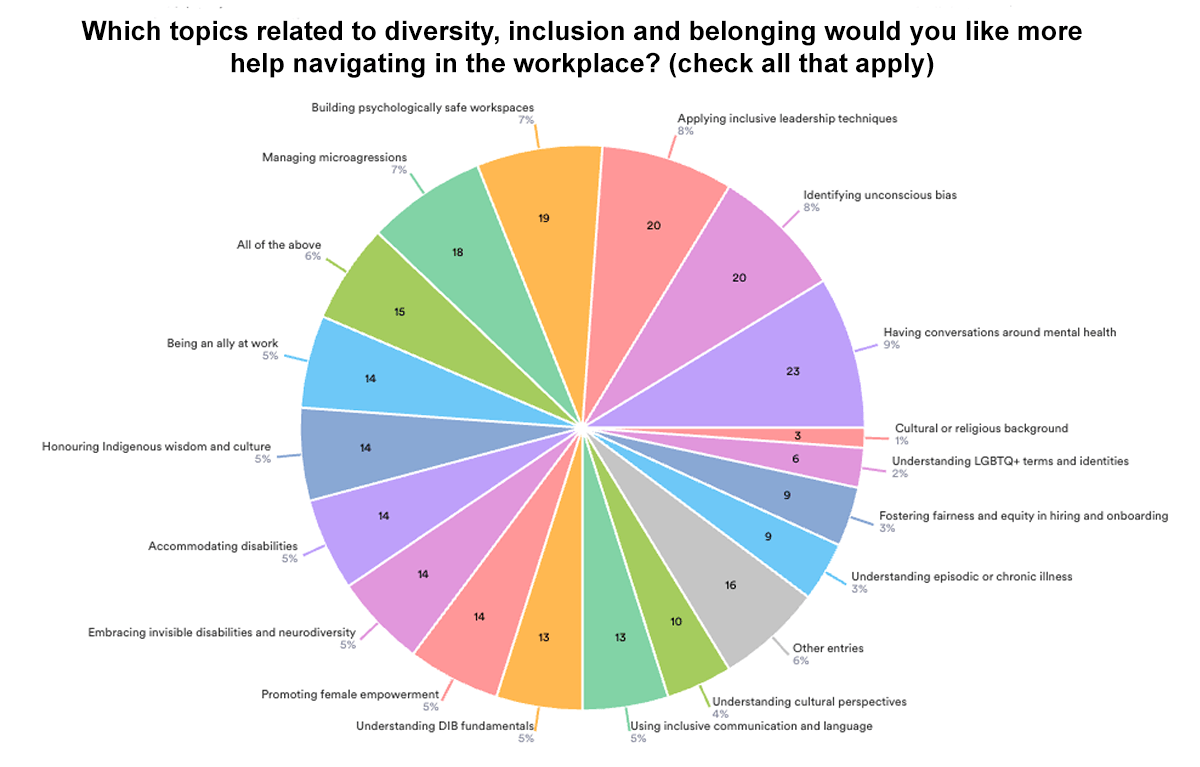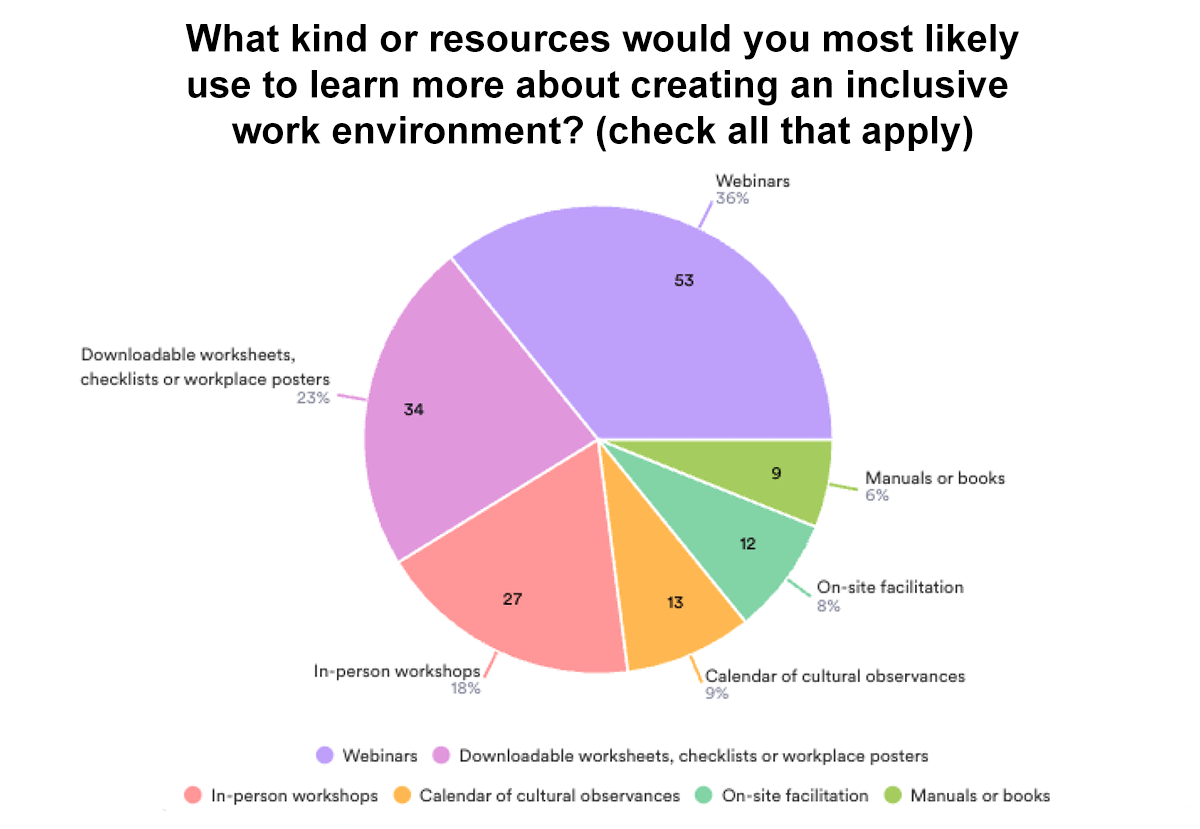May 20, 2025
Diversity, inclusion and belonging:
Insights from the member survey
The Landscape Ontario Diversity, Inclusion and Belonging (DIB) Committee recently conducted a Learning about Diversity Survey to gain insights about what members may wish to learn about diversity, inclusion and belonging at work. The feedback reflected a range of views and experiences.
The short survey wasn’t just about collecting data — it was about listening. The DIB Committee wanted to understand what kind of learning opportunities would be most helpful to LO members and landscape business owners in fostering welcoming environments and attracting a broad and diverse talent pool. The results of the survey will help inform future workshops, resources or events.
The survey ran from March 5 to April 15, and was crafted through collaboration between the LO communications team and a working group from the DIB Committee. They started with questions based on similar DEIB surveys from other industries and refined them through at least three rounds of edits. Some questions allowed for multiple choices, and none were required, so respondents could choose to skip them. The survey was also anonymous and did not collect any identifying information.
How the survey was shared
Since the goal was to determine what kinds of programming LO members were most interested in, the survey was shared within the association rather than publicly through social media. The survey first appeared in the Workforce Development e-newsletter on March 7, and was shared a few more times there, along with being featured in LO’s weekly eNews. It was also sent directly to the 21 members of the DIB Committee, who shared it with their personal networks.The biggest response came after a final push on March 28, when DIB Committee co-chairs Terry Childs and David Milne sent the survey to active chapter and sector board members. That final step resulted in more views and responses than any other method.
Who responded?
Seventy-two people completed the survey. They represented a mix of roles and company sizes — the majority identifying as a business owner/employer (58 per cent). About a quarter identified as a supervisor/team lead/foreperson (23 per cent), and fourteen per cent indicated they are an employee. The remaining fraction represented those currently in education or independent contractors.The committee appreciated all the insights shared by respondents, and found the wide spectrum of opinions very informative.
Most popular topics
 Respondents expressed interest in:
Respondents expressed interest in:
- Having conversations around mental health and building psychologically safe workspaces
- Identifying unconscious bias
- Applying inclusive leadership techniques
- Managing microaggressions
 Many checked “All of the above,” suggesting a broad appetite for growth and awareness. One person noted, “Could easily have checked off all the boxes, but I think we need to start focusing on specific topics.” Someone else shared, “Within my company, I feel safe, but I fear I’ve been mistreated by many other landscapers. It would be good to have mandatory DEI training.” A few wrote in custom suggestions, such as tying in anti-violence and harassment legislation, addressing ageism, helping clarify LGBTQ+ terminology or understanding the implication of various socioeconomic backgrounds.
Many checked “All of the above,” suggesting a broad appetite for growth and awareness. One person noted, “Could easily have checked off all the boxes, but I think we need to start focusing on specific topics.” Someone else shared, “Within my company, I feel safe, but I fear I’ve been mistreated by many other landscapers. It would be good to have mandatory DEI training.” A few wrote in custom suggestions, such as tying in anti-violence and harassment legislation, addressing ageism, helping clarify LGBTQ+ terminology or understanding the implication of various socioeconomic backgrounds.Others suggested the whole endeavour is unnecessary or cautioned against virtue signalling or empty platitudes. One respondent shared, “This should not be the mandate of LO. I think the free market will quickly punish businesses that don’t take care of people. Any reasonably successful business owner already realizes that talented people are talented people regardless of personal attributes.” Another respondent offered up the idea to: “Switch to merit, education and intelligence,” while another said, “We treat all people with the same respect at all times.”
Preferred learning formats
For respondents interested in learning more about the topics presented, the most popular delivery method was webinars (36 per cent), followed by downloadable resources (23 per cent), and in-person workshops (18 per cent). A small portion also liked the idea of calendars of cultural observances, on-site facilitation, manuals or books.
Who are we, really?
The survey asked respondents to rate if they feel comfortable being themselves while attending LO events on a scale of one (strongly disagree) to 10 (strongly agree). Forty-one percent of respondents indicated they feel fully comfortable — an encouraging sign and suggests that the association’s gatherings are already seen as welcoming by many. However, nearly a quarter of respondents do not feel as comfortable, ranking themselves a seven or less. This variation in comfort levels may suggest that some members do not feel fully able to bring their authentic selves to association events.
Bias and barriers
The survey asked if anyone had witnessed or experienced bias, barriers or discrimination based on diversity within their workplace. Of the 72 people who completed the survey, 71 answered this question. The responses were mixed:- 42% said no, they had not witnessed or experienced any such issues
- 38% said yes
- 20% were unsure
 A follow-up, open-ended question invited respondents to share their experiences. Twenty-one people provided written comments. These responses reflected a range of perspectives and experiences.
A follow-up, open-ended question invited respondents to share their experiences. Twenty-one people provided written comments. These responses reflected a range of perspectives and experiences.
Gender-related experiences
Several respondents mentioned incidents of gender bias. Examples included being called “sweetheart” or “darling” on job sites, and assumptions that women lacked technical knowledge. One respondent acknowledged a "glass ceiling" effect but also noted their workplace was otherwise diverse.Racism and cultural barriers
Some respondents reported experiencing racism that impacted their access to information or resources. Others described feeling excluded or misunderstood due to cultural or language differences.Disability and neurodiversity
A few participants noted barriers linked to invisible disabilities or mental health challenges, such as being passed over for promotions or training. One respondent reflected on the lack of understanding around neurodiversity in the workplace and expressed a desire for training to help managers better support neurodiverse employees.Other forms of bias
Additional comments described experiences with ageism, elitism and appearance-based discrimination. One person mentioned hearing homophobic slurs at a networking event.Differing views on DEI efforts
Some respondents expressed concern that diversity initiatives may be perceived as superficial if not backed by meaningful action. One suggested that workplace standards and shared expectations for behaviour could help foster inclusion.Some survey participants voiced skepticism about the need for formal DEI programming. One respondent emphasized hiring based on "character, morals and merit" and preferred to keep personal matters out of the workplace. Another shared that, although they had experienced gender-based discrimination in their career, they were uncomfortable with what they saw as an overemphasis on gender and identity in DEI conversations.